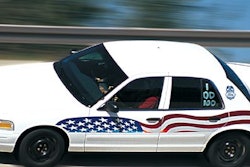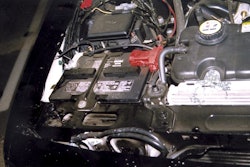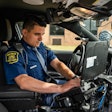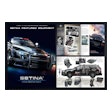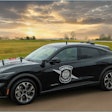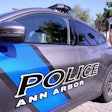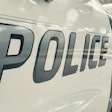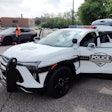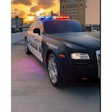You're sitting at a stoplight in your patrol car in a residential area right next to an elementary school. It's early afternoon and you can see kids getting ready to board buses and walk home. As you wait at the intersection a woman zooms past you, running the red light going 50 mph, 25 miles over the speed limit. Should you drive after her, also driving through a red light, hoping she'll stop? Or would a possible high-speed pursuit be more dangerous to the school children and other citizens than the woman's reckless driving?
To know what you would do in this and other situations, ask yourself, "Does the need to pursue outweigh the risks involved?"
Well, to answer this question you need to take into account your agency's pursuit policy and guidelines as well as weather and traffic conditions, police vehicle capabilities, and officer skills and communications-all in a split second. Even then, there isn't always a right answer.
Training
Before they set foot in a patrol car on duty, most officers receive some instruction on emergency vehicle operations during their basic training at the academy. In many jurisdictions, this training is mandated by department policy and/or state law. However, like firearms skills and baton techniques, emergency vehicle operations are considered perishable skills and periodic refresher training is necessary to maintain proficiency. Taking those refresher courses if at all possible is a good start to honing pursuit skills.
Vehicle Safety
Once your skills are in shape you need to make sure your car is in shape for a possible high-speed pursuit. The police vehicle is a vitally important tool during a pursuit. Keeping it well maintained and in good mechanical condition is important to the safety of the officer(s) inside and to the general public. Tires, brakes, and suspension components should all be in proper working order and capable of withstanding high speeds. Substandard brake pads and shock absorbers do not belong on a police vehicle.
The same is true for tires. Many managers have been tempted to replace patrol cars' original equipment (O.E.) tires with less expensive tires under the rationale that their patrol cars "only" operate at low speeds within the city. This practice is false economy and can be dangerous. Alternative replacement tires may alter the handling characteristics of a vehicle, and the tires may fail at the high speeds the vehicle is capable of.
Both the Ford Crown Victoria and Chevrolet Impala are capable of top speeds in excess of 120 mph. The Dodge Intrepid tops out at 135 mph. These cars require tires that are "speed rated" for the cars' top speeds.
Many agencies specify that only original-equipment replacement parts be fitted to their police vehicles. This is for good reason, as aftermarket components may negate certain aspects of the police vehicle, affecting performance, handling, stopping, and reliability. There are also warranty and liability concerns.
Of course, using the right vehicle for pursuits is important, as well. Not all police vehicles are certified as "pursuit" vehicles by the manufacturer. Pursuit-certified vehicles are designed to function under the heavy demands of overall police service. There are also special service package vehicles that are designed for police service. However, the manufacturers have not certified them as pursuit vehicles.
With the quest for more interior room in police vehicles, many agencies are looking toward Sport Utility Vehicles. But with the exception of older vintage Chevrolet Tahoes, the only currently manufactured SUV that is pursuit-certified is the Hummer, with a top speed of 85 mph. Using a vehicle that is not pursuit-certified is asking for problems.
Regardless of the type of vehicle being driven, every officer should thoroughly inspect his or her patrol vehicle before going on duty. Do the lights and siren work properly? Is safety equipment in order? Brakes, tires, and shock absorbers in good working order? Are the tires properly inflated? Fuel tank full?[PAGEBREAK]
Remain Calm and Alert
There are many factors that can affect an officer's performance under stressful conditions. And a high-speed pursuit definitely fits under that category. Proper selection and training of personnel is important. Other factors that are harder to control, such as shift work and the long hours that police officers are required to work, can affect judgment-often adversely.
One of my fellow officers, normally assigned to work graveyard shift, was ordered to work past his end-of-shift by a supervisor. The officer complained that he was too tired to properly drive a car after working all night. The supervisor ordered him to work anyway. A couple of hours later, while pursuing a suspected burglary suspect into the inner city, the officer skidded into a telephone pole, injuring him and "totaling" the cruiser.
Lack of sleep as well as medications-both prescription and "over the counter"-can affect motor skills and judgment. Warning labels that suggest caution when operating and/or driving should not be taken while on duty.
Even if you are wide awake and taking no medication, you could be susceptible to "tunnel vision." This phenomenon is when an officer focuses on the target (the suspect vehicle) and his or her visual acuity eliminates everything else. Tunnel vision is prevalent in many stressful police functions-and especially in pursuit situations. Officers have to discipline themselves not to let tunnel vision get control of them.
Also keep your temper under control. Emotions have a tendency to boil over, especially during long pursuits.
The Chase is On...
The violator has failed to yield to the officer's signal to stop, and the officer is now in pursuit-assuming that the needs of the pursuit outweigh the risks involved, that the pursuit is approved by the officer's supervisor, and that it is within agency policy.
A secondary unit should be assigned, along with a supervisor. Once in position, the secondary unit should broadcast the pursuit, thus freeing the primary officer to concentrate on driving. Department policy should be flexible so that enough secondary units can be assigned, in case of multiple suspects. A supervisor should be directly involved in the pursuit.
Use Available Resources
If available, air support in the form of a plane or helicopter should be notified. Personnel in the air can broadcast a pursuit, locate suspects who flee on foot, and vector officers on the ground to strategic areas. An aircraft is a valuable tool, especially if the pursuit is in an urban area where cross traffic can be a threat. Air assets can vector other units to close strategic intersections to reduce the threat of a collision.
A K-9 unit may also be useful at the end of a pursuit in clearing the suspect vehicle after it has stopped.
If a pursuit leaves the jurisdiction of the pursuing officer's agency, the surrounding jurisdiction(s) should be notified. Agency policies vary and other agencies may or may not be of assistance. It would be helpful to understand the policies of nearby agencies just in case such a situation should occur.
Ending the Pursuit
"Legal Intervention" techniques, such as ramming, "spike strips," or firearms usage, can fall into the category of deadly force. These techniques should only be utilized if approved by the agency and if the situation warrants such tactics.
Several agencies, including the California Highway Patrol, authorize a ramming technique under certain circumstances to attempt to spin the suspect vehicle off of the roadway. The Tucson (Ariz.) and Albuquerque (N.M.) Police Departments teach their officers a technique designed to spin the suspect vehicle around so secondary units can box the vehicle in, immobilizing it.
In theory, spike strips flatten a suspect's tire(s), thus making the suspect's vehicle immovable. But keep in mind that things don't always go as planned. There have been several documented incidents where the suspect has continued on, flat tires and all, sometimes emitting a shower of sparks from running on the wheel rims. A recent Southern California pursuit resulted in fatalities when a driver elected to continue to flee from police driving on the car's wheel rims and lost control of the vehicle at high speed.
Because you never know what will happen, always be prepared for a pursuit. Keep your vehicle and yourself in working order, know your department's pursuit policies, and be ready for whatever comes your way.
Pursuit Driver Training
Many agencies offer excellent training in emergency vehicle operations. One of the pioneers is the California Highway Patrol's Emergency Vehicle Operations Course (EVOC), which began in the 1950s. The EVOC facility is located at the CHP Academy in West Sacramento. Part of its driving course even has a replicated stretch of four-lane freeway so that officers can practice freeway stop techniques.
Surprisingly, as crowded and congested as the City of Los Angeles is, the LAPD did not offer EVOC training in its basic academy until the early 1970s. Started by then-sergeant Jerry Trent, a former Freeway Interceptor driver, LAPD's EVOC course has occupied several locations until finally moving to its current facility a few years back.
The Michigan State Police Precision Driving Unit (PDU) offers not only pursuit driver training, but also an instructor's course.
In the private sector, The Bob Bondurant School of High Performance Driving offers courses in pursuit driving to law enforcement. Bondurant, a former racing driver has been involved in pursuit driver training since the early 1970s. Bondurant's school is located in Phoenix, Ariz. www.bondurant.com.
As incredible as it may seem to our way of thinking, British police actually conduct some of their pursuit driver training on city streets among commuter traffic. In 1995 a police driving instructor was portraying a thief and trying to outrun his students in a mock pursuit, when his car slammed into the rear of a stationary automobile occupied by a 27-year-old student nurse. The nurse died as a result of the collision and the instructor was found guilty and fined for "careless driving."
Police Tires
Replacement of Original Equipment (O.E.) tires on a police vehicle with tires that vary from O.E. specifications is not recommended. These replacement tires can adversely affect braking, handling, and overall performance. These replacement tires may not wear as well, either.
Even for agencies that forbid pursuits, or whose jurisdictions involve low-speed roadways, fitting tires other than O.E. specifications is not a good idea. For the officer conducting speed enforcement on a 40-mph road, if a violator is doing 60 mph, then the officer must do 80 mph, or more, just to catch up.
Today's tires are "Speed Rated" and that speed rating will be marked on the sidewall. The current speed ratings follow:
Q: 99 mph
S: 112 mph
T: 118 mph
U: 124 mph
H: 130 mph
V: 149 mph
Z: 149 mph and over
W: 168 mph
Y: 186 mph
A tire's performance on wet and dry pavement can vary, so take into account your area's weather. An agency that experiences a lot of rainfall should be concerned with wet-weather performance, while Southwestern agencies should place more emphasis on dry-weather performance.
The National Law Enforcement and Corrections Technology Center (NLECTC) periodically conducts tests of police tires. For a copy of their test results, contact them at:
NLETC
P.O. Box #1160
Rockville, MD 20849-1160
(800) 248-2742
www.justnet.org
John L. Bellah is a working police officer with more than 25 years of experience. He contributes to numerous publications on law enforcement and automotive topics.






